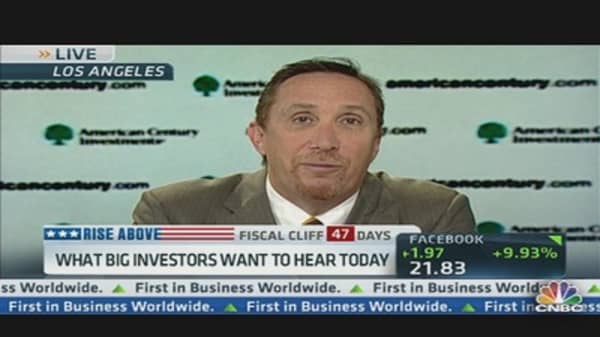CHICAGO — With all of the cross-currents in the present economic and political climate, it's become a given that many investors want to avoid the risks of stocks and embrace the relative safety of bonds.
What they don't realize is they may actually be taking on more risk by reaching for returns in overbought fixed income instruments, says John D. Boritzke, director of tax-exempt fixed income at BMO Global Asset Management.
While he rejects the broader concept of a bond bubble, he does believe that the exodus of investors from equities to fixed income holds peril for those who aren't mindful enough of the risks. (Read More: Morici: Trade Deficit, Fiscal Cliff Threaten Second Recession)
"From that perspective, it's a bit worrisome," Boritzke said during a break in the action at the Charles Schwab Impact 2012 conference. "Bond investors have not had to suffer price declines. That experience may be new to people who have become more aggressive. If there's a bubble in part of the market it's there's way too much money flowing into high-yield. Some of the deals being priced into the market are becoming too aggressive."
In terms of fund flows, investors have flocked from stock-based mutual funds and into bond instruments.
High-yield, or junk bonds, have benefited especially as they offer handsome yields at a time when 10-year government debt rates are around 1.60 percent.
"The safest, most secure bonds you can buy — Treasurys — just don't offer attractive yield opportunities," Boritzke said. "After taxes, you just don't have enough to keep pace with inflation, and this is with inflation being relatively low."
The most recent Citigroup survey of bond investors put inflation expectations around 2.5 percent — above the Federal Reserve historic target but still fairly anchored.
With Washington trying not to go over the "fiscal cliff" — Fed Chairman Ben Bernanke's term for tax increases and spending cuts that go into effect in 2013 unless deficit-reduction targets are hit — that presents special challenges to fixed income investors.
Boritzke deals primarily with high-net-worth clients whom he is advising to move away from the flock of long-duration high-yield buyers and focus elsewhere.
"The flows have been incredibly huge (to high-yield) although defaults have been historically low. That's where the fiscal cliff has implications," he said. "We don't have a lot of room for error, plus or minus, in terms of GDP."
He's recommending clients keep their duration in medium range — seven years or so — and moving up the quality ladder even though it may reduce yields.
"You're not getting paid a lot to extend either" duration or credit risk, Boritzke said. "The intermediate portion of the curve still offers opportunity."
"We would suggest that upper-income taxpayers still allocate a significant portion of bond money to the municipal bond market, which is slowly recovering," he said. (Read More: Why Muni Bonds Are Suddenly So Popular With Investors)
California education bonds are one recommendation that BMO makes.
The state, known for its long history of fiscal recklessness, recently passed a budget mandate that allows for higher taxation on upper-income earners. Taxes are a muni bond investor's best friend, as they help guarantee payment of obligations.
Such choices will be critical in an environment that is likely to see higher taxes not only in California but also through the rest of the country.
"If the fiscal cliff comes to fruition then what we would suggest is that you take some profits from higher-yielding investments that have done well so far but under a slower economic growth scenario may not hold up," Boritzke said. "The general suggestion would be upgrade the quality of your portfolio."





